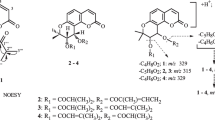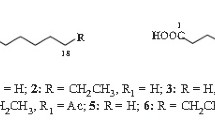Abstract
A total of fifteen saturated fatty acid esters were newly identified from the secretions of an unidentified Anaulaciulus sp. (Julida: Julidae). The fatty acid components of the esters were composed of normal chain acids (from C10 to C14) and of branched chain acids (from iso-C12 to iso-C15 and anteiso-C15). The alcohol moieties were all composed of normal chain alcohols varying from n-butanol to n-octanol. The most abundant component found in the total esters was n-hexyl laurate (64.7%). Novel compounds identified from the millipede secretion extracts include six branched iso- and anteiso-fatty esters, an odd-numbered C11-fatty acid ester, a C13-fatty acid ester, and a C7-alcohol ester, all of which were previously undescribed natural products. In addition, a characteristic mixture of benzoquinones, such as 2-methyl-1,4-benzoquinone, 2-methoxy-3-methyl-1,4-benzoquinone, 2,3-dimethoxy-1,4-benzoquinone, 2-methoxy-6-methyl-1,4-benzoquinone, and 2,3-dimethoxy-5-methyl-1,4-benzoquinone were identified from the secretions, together with trace amounts of 1,4-benzoquinone.

Similar content being viewed by others
References
Arab, A., Zacarin, G. G., Fontanetti, S. C., Camargo-Mathias, M. I., dos Santos, G. M., and Cabrera, C. A. 2003. Composition of the defensive secretion of the Neotropical millipede Rhinocricus padbergi Verhoeff 1938 (Diplopoda: Spirobolida: Rhinocricidae). Entomotropica. 18:79–82.
Attems, C. 1909. Die myriopoden der vega expedition. Ark. Zool. 5:1-85.
Behal, A. and Phisalix, M. 1900. La quinone, principe actif du venium du Julus terrestris. Bull. Mus. Nat. His. Natur. (Paris) 6:388-390.
Blum, M. S. and Woodring, J. P. 1962. Secretion of benzaldehyde and hydrogen cyanide by the millipede Pachydesmus crassicutis (Wood). Science. 138:512-513.
Blum, M. S., Macconnell, J. G., Brand, J. M., Duffield, R. M., and Fales, H. M. 1973. Phenol and benzaldehyde in the defensive secretion of a strongylosomid millipede. Ann. Entomol. Soc. Am. 66:234-235.
Breed, M. D., Stiller, T. M., Blum, M. S., and Page, R. E. 1992. Honeybee nestmate recognition: effects of queen fecal pheromones. J. Chem. Ecol. 18:1633–1640.
Duffey, S. S., Blum, M. S., Fales, H. M., Evans, S. L., Roncadori, R. W., Tiemann, D. L., and Nakagawa, Y. 1977. Benzoyl cyanide and mandelonitrile benzoate in the defensive secretions of millipedes. J. Chem. Ecol. 3:101-113.
Eisner, T. and Meinwald, J. 1966. Defensive secretions of arthropods. Science. 153:1341–1350.
Eisner, T., Alsop, D., Hicks, K., and Meinwald, J. 1978. Defensive secretions of millipedes, pp 41–72, in S. Bettini (ed.), Arthropod venoms. Handbook of experimental pharmacology, vol. 48. Springer-Verlag, Berlin.
Eisner, T., Aneshansley, D. J., Eisner, M., Attygalle, A. B., Alsop, D., and Meinwald, J. 2000. Spray mechanism of the most primitive bombardier beetle (Metrius contractus). J. Experm.Biol. 203:1265–1275.
Grula, J. W. and Taylor, O. R. 1979. The inheritance of pheromone production in the sulphur butterflies Colias eurytheme and C. philodice. Heredity 42:359–371.
Grula, J. W., Mcchesney, J. D., and Taylor, O. R. 1980. Aphrodisiac pheromones of the sulphur butterflies Colias eurytheme and C. philodice (Lepidoptera, Pieridae). J. Chem. Ecol. 6:241–256.
Kuwahara, Y. 1999. Chemical defenses of millipedes, pp 291–298, in T. Hidaka, Y. Matsumoto, K. Honda, H. Honda and S. Tatsuki (ed.), Environmental entomology, behavior, physiology and chemical ecology. University of Tokyo Press, Tokyo (in Japanese).
Kuwahara, Y., Noguchi, S., Mori, N., and Higa, Y. 2002. Identification of benzoquinones and hydroquinones as the secretory compounds from three species of Okinawan millipedes. Jpn. J. Environ. Entomol. Zool. 13:117–124.
Kuwahara, Y., Mori, N., and Tanabe, T. 2007. Detection of a neotropical frog alkaloid spiropyrrolizidine 236 from a Japanese polyzoniid millipede Kiusiozonium okai as a major defense component together with polyzonimine and nitropolyzonamine. Jpn. J. Environ. Entomol. Zool. 18:91–95.
Meinwald, J., Smolanoff, J., Mcphail, A. T., Miller, R. W., Eisner, T., and Hicks, K. 1975. Nitropolyzonamine: a spirocyclic nitro compound from the defensive glands of a milliped (Polyzonium rosalbum). Tetrahedron Lett. 16:2367-2370.
Meinwald, Y. C., Meinwald, J., and Eisner, T. 1966. 1,2-Dialkyl-4(3H)-quinazolinones in the defensive secretion of a millipede (Glomeris marginata). Science. 154:390-391.
Monro, A., Chadha, M., Meinwald, J., and Eisner, T., 1962. Defensive mechanisms of arthropods VI. Para-benzoquinones in the secretion of five species of millipedes. Ann. Entomol. Soc. Am. 55:261–262.
National Institute of Advanced Industrial Science and Technology, The spectral data base of organic compounds. Website accessed February 2010, http://riodb01.ibase.aist.go.jp/sdbs/cgi-bin/direct_frame_top.cgi
Ômura, H., Kuwahara, Y., Tanabe, T. 2002a. Species-specific chemical compositions of defense secretions from Parafontaria tonominea Attems and Riukiaria semicircularis semicircularis Takakuwa (Polydesmida: Xystodesmidae). Appl. Entomol. Zool. 37:73–78.
Ômura, H., Kuwahara, Y., Tanabe, T. 2002b. 1-Octen-3-ol together with geosmin: New secretion compounds from a polydesmid millipede, Niponia nodulosa. J. Chem. Ecol. 28:2601–2612.
Pasteels, J. M., Grégoire, J. C., and Rowell-Rahier, M. 1983. The chemical ecology of defense in arthropods. Annu. Rev. Entomol. 28:263–289.
Peschke, K. and Eisner, T. 1987. Defensive secretion of the tenebrionid beetle, Blaps mucronata: Physical and chemical determinants of effectiveness. J. Comp. Physiol. A. 161:377–388.
Röper, H. and Heyns, K. 1977. Trace analysis of p-benzoquinone- and hydroquinone derivatives by gas-liquid chromatography and gas-liquid chromatography/mass-spectrometry. Identification of defensive secretion components from European Julids. Z. Naturforsch. 32C:61–66.
Sarova, D., Kapoor, A., Narang, R., Judge, V., and Narasimhan, B. 2011. Dodecanoic acid derivatives: synthesis, antimicrobial evaluation and development of one-target and multi-target QSAR models. Med. Chem. Res. 20:769–781.
Shinohara, K. 1990. Three new species of the genus Anaulaciulus (Diplopoda: Julidae) from Japan. Edaphologia 42:21-25.
Weatherston, J. and Percy, J. E. 1969. Studies of physiologically active arthropod secretions. III. Chemical, morphological, and histological studies of the defence mechanism of Uroblaniulus canadensis (Say) (Diplopoda: Julida). Can. J. Zool. 47:1389–1394.
Wheeler, J. W., and Meinwald, J., Hurst, J. J., and Eisner, T. 1964. Trans-2-dodecenal and 2-methyl-1,4-quinone produced by a millipede. Science. 144:540–541.
Wood, W. F., Hanke, F. J., Kubo, I., Carroll, J. A., and Crews, P. 2000. Buzonamine, a new alkaloid from the defensive secretion of the millipede, Buzonium crassipes. Biochem. Syst. Ecol. 28:305–312.
Acknowledgements
This work was supported in part by Agricultural Chemical Research Foundation and by a Grant-in-Aid for Young Scientists (B) [No.20780086 for NS] from the Japan society for the promotion of Science (JSPS).
Author information
Authors and Affiliations
Corresponding author
Rights and permissions
About this article
Cite this article
Shimizu, N., Kuwahara, Y., Yakumaru, R. et al. n-Hexyl Laurate and Fourteen Related Fatty Acid Esters: New Secretory Compounds from the Julid Millipede, Anaulaciulus sp.. J Chem Ecol 38, 23–28 (2012). https://doi.org/10.1007/s10886-012-0063-4
Received:
Revised:
Accepted:
Published:
Issue Date:
DOI: https://doi.org/10.1007/s10886-012-0063-4




